Blog 10 – Working in Carnarvon, then on the road again – June 2009
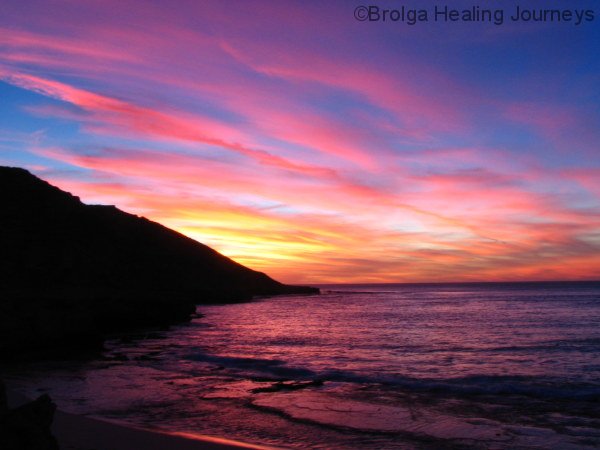
Contrary to what you may all be thinking, we are still alive, we are still travelling, we are still together and yes – we are still enjoying our adventure, loving it in fact. It’s just that life, work and travel have all interfered with our capacity to write this blog.
Where did the time go? Well, since our previous blog way back in October 2008 we’ve been pretty busy.
WORKING & PLAYING IN CARNARVON
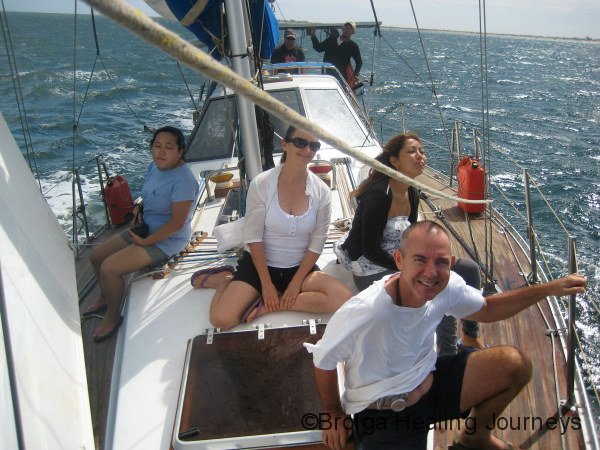
We ended up staying in Carnarvon for around 7 months, mainly in the interests of avoiding the extreme heat of summer in the “top end” of the country, and also to earn enough money to keep us on our travels. Carnarvon turned out to be a great place to stop, providing us with plenty of work opportunities but even better, enabling us to meet some great new friends.
Nirbeeja worked the whole time for Desert Sweet Bananas, at Margaritaville Plantation, in the packing shed; appropriate really for an ex-Queensland girl. (Needless to say the locals accused her of being a Qld spy. She had a great time there, working with a great bunch of people (excuse the pun) who made what could otherwise be monotonous work a lot of fun. She loved her interactions with all the gang, especially Cherelle (the owner), Reggie (one quarter shed supervisor and three quarters larrikin) and her fellow packers, of whom she was closest to Akiko (a young lady from Japan) and Nari (a young lady from South Korea). Nirbeeja, who went by the name of Lily while we were in Carnarvon in the interests of not having to explain her name every five minutes, enjoyed helping the girls to improve their English. Some of their conversations were priceless. For instance, how do you discuss the frequent Australian use of the term ‘bugger’ without alarming our foreign visitors when it came to defining the word. And there is nothing quite like hearing ‘bugger’ said with a thick Japanese accent. And just how do you get across the idea that you can call someone a “son of a bitch” but not a “daughter of a bitch”? But don’t worry, it wasn’t all to do with expletives. I recall Nirbeeja spending one whole session explaining the use of the phrase “I appreciate that” to Akiko, and another dealing with “either, or” and “neither, nor”. The girls loved these interactions and Akiko’s English improved enormously through them; come to think of it, so did Nirbeeja’s.
The plantation has three little dogs that are loved by all. The oldest – Merry – a tiny Chihuahua not much bigger than a mouse – has the heart of a lion and loves working out in the rows of banana trees with the boys. Missy, a bitser, similarly loves her work out in the fields and simply adores Bruce – the supervisor of the plantation workers. And the youngest dog – Chilli, another Chihuahua – who Peter called the Prince, preferred to be driven around the plantation on a quad bike, surveying the efforts of the workers from the safety and comfort of the padded seat. Needless to say, Chilli’s main challenge involves keeping his weight down. Actually, Chilli couldn’t care less about his weight; it is more the concern of his owners Cherelle and Darryl.
Never one to miss out on fun, I also started working at the plantation. My role was more solitary, wandering up and down the rows of bananas cleaning around the bunches with a long handled knife. I would occasionally come across other humans while out in the field. Plantation owner Darryl would turn up occasionally on his quad bike (accompanied by Chilli), purportedly to check on my work progress but more likely to check that I was still alive and not victim of a Gwadar (Western Brown Snake) bite. And I would occasionally run into Bruce and his team of banana pickers. But mostly my time was spent alone, kept relatively sane by my iPod. Oh, and I loved getting together at the end of each day for a well-earned beer in the packing shed with the other troops. Beer has never, ever tasted so good, especially during a thankfully short period in January when temperatures reached the mid 40s.
We all worked hard on the plantation, but there was also a great sense of play and fun there. Darryl and Cherelle hosted Christmas at the plantation and organised several day trips, one boating around the Carnarvon inlet, another to the Blowholes area for some swimming and snorkelling and yet another on an ocean going yacht. The yachting proved very enjoyable. More correctly, the first half proved enjoyable. Everyone was in high spirits, talking, laughing and generally carrying on. Then the swell picked up and sea-sickness set in for most of us. (I will throttle the next person to say it is all in the mind). It was a much quieter crew indeed on the trip back to calmer waters.
Cherelle and Darryl become great mates of ours and we miss them enormously. Obviously, they appreciated our work there, as you can see from the references they gave us.
We did get ‘official’ references from them but they aren’t nearly as much fun.
I spread myself around (work-wise) in Carnarvon, also doing the bookkeeping for Jason and Kylie of Coral Coast Plumbing, working one day each week as herbalist/homeopath at Gascoyne Chiropractic (thanks for making me part of the team, Kim & Brett) and in the final few months working at Wintersun Caravan Park, our home in Carnarvon, as caretaker, receptionist and cleaner (thanks Tiffany & Simon). Nirbeeja also did some cleaning work at Wintersun. We were really well looked after in all these roles and have very fond memories of all our work (and play) experiences in Carnarvon.
One great memory of our stay in Carnarvon was the time, in late January, when the Gascoyne River flowed. Indeed it broke its banks, flooded a good part of Carnarvon and even threatened the caravan park. Normally, the Gascoyne River appears to be a wide expanse of sand, although we learned that a large quantity of water constantly flows beneath its apparent surface. At the same time that Victoria was burning and Queensland flooding, a cyclone hit the Pilbara region to the north of Carnarvon. Not a drop of rain fell in Carnarvon itself. But the greater Pilbara received massive falls; rivers flowed and roads and railways were washed away. It took around a week for these rains to drain their way down the Gascoyne River to Carnarvon, where the river rose from 0 metres to peak at 6.9 metres within the space of an hour. It was quite a sight!! The road in front of Wintersun was awash, as was the neighbouring plantation. (Margaritaville Plantation was also partly flooded.) Unsure as to just how high the river would get, we helped prepare for the worst at Wintersun, raising all the office furniture and washing machines etc. But to our relief the caravan park didn’t flood, though we figured that another half metre to the river height would have made life very interesting. A lower lying caravan park down the road wasn’t so lucky, with waist deep waters flooding vans and tents there. We were astounded at the volume of water that flowed along the Gascoyne River and out to sea. Fortunately, not all the water was ‘wasted’, as a large amount would have soaked through the sand to top up the underlying water table, which constitutes the water supply for Carnarvon and its plantations.
Then, within a week or so, the river stopped flowing, the pools dried up and the surface of the Gascoyne was once again sand.
ON THE ROAD AGAIN
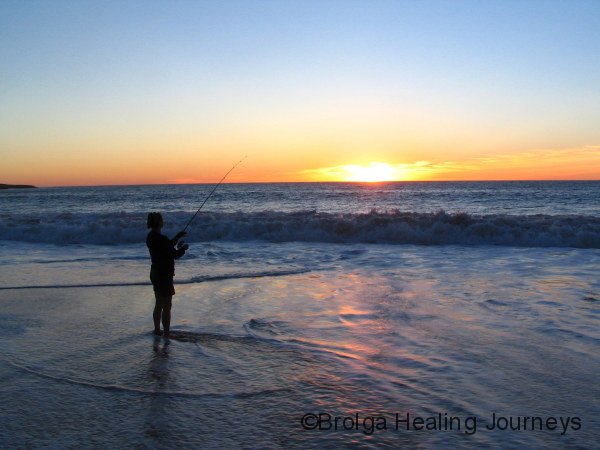
We left Carnarvon in early May, feeling a mixture of excitement and sadness, to recommence our adventures on the road. We must admit to feeling relief at not becoming two more people who have stopped off in Carnarvon for just a few months but are still there 20 years later.
Our first stop was at Red Bluff, a few hours up the coast from Carnarvon. We stayed a week at this beautiful place which is dominated, as its name suggests, by its red headland. We had one of our best campsites ever – overlooking the beach and its massive waves. The only drawback was the sound of the waves at night, the roar and crash of them pounding the shore waking us constantly, in fact Nirbeeja brought her ever-ready ear-plugs into good use during this time. But this was a small price to pay for such a gorgeous spot. The ocean was teaming with life – dolphins, giant manta rays, turtles, sharks, sea-snakes and fish. And the sunsets were exquisite.
We swam every day, or rather, were pounded into submission each day by the waves dumping on the shore. It was a lot of fun, but also nice to leave the surf alive each time. There is nothing quite like being totally at the mercy of a huge wave.
One afternoon we were swimming/surviving in the surf when some fishermen began cleaning a huge Spanish Mackerall they had just caught. As they prepared to dump the resulting burly in the ocean, we decided to leave the water. In hindsight this was wise, because within a matter of minutes three sharks were thrashing around close to the shore, fighting over the remains. Mind you, they were reef sharks, which aren’t regarded as man-eaters, but at the time they looked pretty threatening.
Nirbeeja explored some new pastimes at Red Bluff, trying her hand at surf fishing and sketching. Her fishing wasn’t particularly successful, though her efforts at casting entertained me for hours. Her sketching has given her something else to explore on our travels. Stay tuned for news of her first exhibition.
Red Bluff was a very friendly place. While we weren’t successful with our fishing efforts, others were, and were happy to share their fish with other campers. We had some lovely seafood meals at Red Bluff, particularly the large Spanish Mackerall steaks courtesy of our neighbours.
WHALE SHARKS OFF EXMOUTH
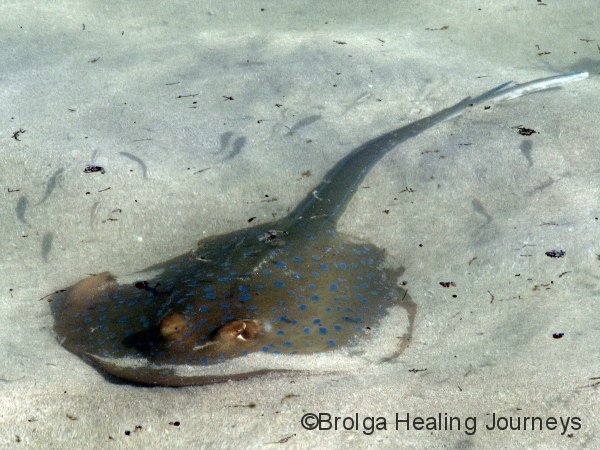
Next it was off to Exmouth for what we hoped would be a swim with Whale Sharks. En route we stayed overnight at a free camp next to the highway, where I did my ‘Knight in Shining Armour” impersonation to help two young terrified German backpackers (female, surprise, surprise, says Nirbeeja) whose car had been invaded by “monsters”, which turned out to be giant grasshoppers. This reminded us of how frightened the Asian girls were in Carnarvon of the local insects; things which we tend to take for granted in Australia.
We arrived in Exmouth once again lucky to get the last available camping spot in Cape Range National Park. It was great to return there and again see the abundance of wildlife – the turtles on the beach, kangaroos everywhere, emus, and echidnas. At Turquoise Bay, as we prepared to go snorkelling, we were greeted by the sight of a young dolphin swimming by us only about 10 metres away.
And then came the reason for our return to the region – the day cruise to swim with the Whale Sharks. Would we see any?? We certainly did. In fact, that day we swam with Whale Sharks on 9 separate occasions. We don’t know whether we swam with 9 different sharks or had repeat swims with some, but it was a fantastic day and a real highlight of our adventures. By all accounts the sightings this year from Exmouth have been excellent, in keeping with our experience, though the tour operators believe it will be a short, concentrated season. By contrast, many tours heading out from Coral Bay, further down the coast, were seeing very few sharks. So we consider ourselves to be most fortunate indeed.
It was exhausting, but the most exhilarating day ever. The sight of a Whale Shark takes your breath away, especially in the water. Their size is almost surreal. The longest we saw was around 7 metres – and in Australian waters they can reach 14 metres long. But when confronted by a 7 metre shark underwater, it seems more like 70 metres.
We had 14 people on our tour with Ningaloo Blue, and we were split into 2 groups, each with its own guide who would point out the shark to the group once we were all in the water.
When a shark was sighted it would be panic stations! “Group one get ready” and you’d don flippers, snorkel and goggles, then “GO GO GO”. A big step off the marlin board at the back of the boat into the water. “Which end is up?” You’d come to the surface, check goggles, snorkel etc, followed by a frantic look around for the whale shark – then – “Oh My God – it’s coming right at me”. Evasive action, then a mad chase to keep it in sight and to try – usually unsuccessfully, to keep up with the guide and the Whale Shark. How did the guides do it? They would swim, one arm held up above the water, the other pointing underwater in the direction of the shark, and still we couldn’t keep up with them!! Maybe it was the huge flippers they wore. Maybe they were part fish. And then there was Vee – a Brazilian underwater videographer whom Nirbeeja and I believed to be more mermaid than human. She was amazingly graceful and lithe underwater all the while holding a large camera out in front of her. Us – well we were mainly trying not to drown while enjoying the thrill of the whale sharks.
At first we wore wetsuits provided by Ningaloo Blue but in Nirbeeja’s case the suit was too large and allowed quite a bit of water in. As a result she struggled at first and was extremely grateful for the safety zodiac, which followed us at all times in case you needed help. Once she ditched the wetsuit (figuratively speaking) she was fine. But no, she didn’t swim naked; she had a bathing suit underneath.
The Whale Sharks were beautiful. Gentle, graceful creatures that swam along in what appeared to be a leisurely manner but which always left us in their wake. Their tail fin was taller than us, so that probably goes some way to explaining how they swam so quickly. On occasion they would tire of all the silly humans thrashing about them, and dive for the solitude of deeper water. I was amazed to watch one of these huge creatures descend into the depths and disappear from sight, a tiny speck below. It was only then that I realised just how deep the waters were in which we swam.
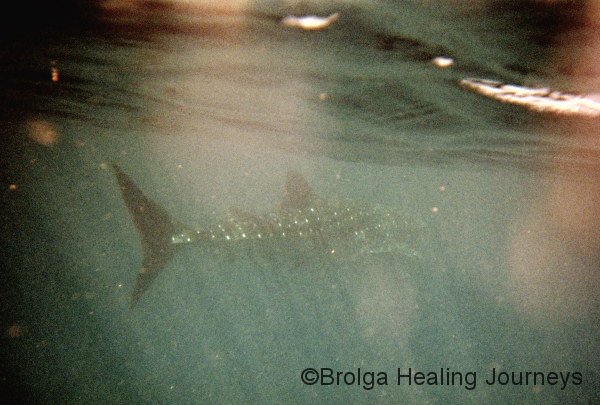
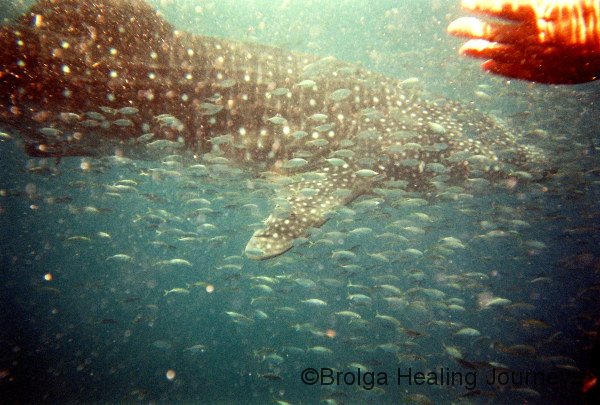
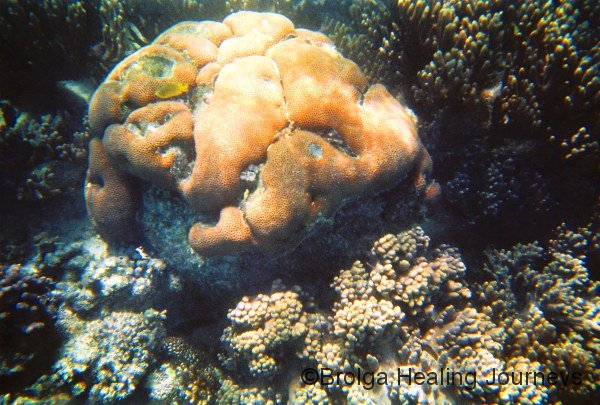
The tour companies do everything possible to minimize their effect on the sharks, but you can’t help but get in the way at times. And as our guide said – “they are the biggest thing in the ocean so they don’t move aside for anything”. I can attest to that, after scrambling (is that the aquatic term) to get out of the way of one coming straight at me, its mouth looking for all the world like a chasm.
We were provided with fantastic food –dips and antipasto for morning tea. A great lunch of cold meats, chicken, and a fantastic range of gourmet salads. We had cooled water and cordials on tap all day.
Then to top it all we were treated to a couple glasses of bubbly to finish off the day.
One of the best days ever, that one.
As an interesting aside, the first people we met that day were Kerrie and Andrew, a couple from Queensland. It turns out that during the 1990s they lived on some land sold off from a Buderim farm by the elderly farm-owners. And who were the farm-owners? Nirbeeja’s parents, and Kerrie and Andrew had become good friends with them. What a small world.
Apart from the photos shown above, we also have a DVD of our adventures, thanks to our videographer Vee, in case anyone is ever really, really bored and wants to see footage of someone else’s holiday. Having said that, the DVD does contain some great video of the Whale Sharks, and of your correspondents floundering in their wake.
WE TRAVEL INLAND
We departed from Exmouth, thrilled that our Whale Shark encounter had proved to be all that had could ever have hoped for.
We decided to retrace some of our earlier travels, to Tom Price and Karijini, before exploring any new destinations. We stopped at the free camp at House Creek en route to Tom Price. This again proved a beautiful spot with an enormous variety of birds; the morning chorus would have woken the dead. We were happy, at last, to get a really good sighting of the Blue Winged Kookaburra, a native of the Pilbara region of Western Australia and northern Australia, which is smaller than the Laughing Kookaburra, unlike its bigger counterpart, only lets out a raucous disjointed call with no discernable melody, and only an occasional brief cackle. But its blue wings, soft cream coloured chest and relatively large beak still make it a sight to behold.
We stayed two nights to enjoy the birdlife, and on the second enjoyed a campfire with a couple from Sydney, two Qld brothers, a young German couple (for whom it was the first night of free camping, because they had been warned of the dangers of it!) and a young French couple who had been camped in the adjacent spot to us in Cape Range. A real United Nations of an evening.
Next we stopped in at the ‘secret’ Kasput Pool, hoping for a return to the idyllic conditions we met when we camped there in September. But this was not to be. The adjacent cattle station obviously had used the area around the pool for cattle mustering, and the whole area reeked of dung, the soil was trampled, the pool polluted and the beautiful reeds chewed off at the base. It was a major disappointment – so off we trooped to Tom Price.
We had 2 nights there, again catching up with our friends Cate, Seamus and their daughter Zoe. The cold nights were a shock to the system after months spent growing soft on the coastal fringes. The first night dropped to 4 degrees, followed by 3 degrees the next and had us scrambling for our winter woolies. But at least the days were beautiful.
Off we headed to Karijini National Park which had been a highlight of our trip when we first visited. We were pleasantly surprised to find that the dirt road into the park had been graded. Yippee! we thought. But that joy was to be short-lived, for graded or not, the roads our there largely consist of hard, sharp rock. We blew (actually, shredded, is a better term) one of the tyres on the camper trailer. And the tyre had been in good condition and was a genuine off-road type. Anyway, we changed the tyre (having first emptied out the trailer to reduce weight on the jack) returned to Tom Price, got a new spare, then made the return trip to the western end of Karijini to stay at the Eco Retreat, driving, it must be admitted, with undue caution on this occasion.
Karijini was again beautiful. Our first visit had been greeted by a profusion of wildflowers. Conditions were quite different this time – but just as spectacular. The spinifex grasses were all in seed, providing a lovely soft contrast to the dark red soil and jagged rock formations. It was truly beautiful.
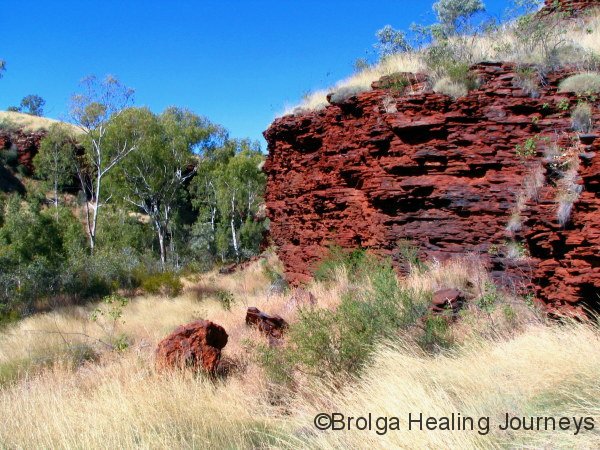
We took the opportunity on this return visit to go on several bushwalks and climbs that we had missed on our first time there, walking the Weano Gorge route and me opting for the class 5 (ie hard) extension to that walk by scrambling down to Handrail Pool at the end of that gorge. It was worth the effort, though with heavy clouds looming overhead I didn’t linger at the pool because of the risk of flash flooding (over the years a number of people have drowned in Karijini’s gorges following flash flooding caused by rains falling elsewhere in the park).
We left the Eco Retreat and headed to the eastern end of the park. Unfortunately, this 30 odd km road was just as bad as our first time in the park. The grader was just starting the arduous job as we commenced our drive. Rattle bump, rattle bump, we finally made it across to the extremely welcome bitumen at the Dales Gorge (eastern) side of the park. A few days there relaxing, getting into our respective yoga and tai chi practices in a big way, and re-exploring the gorge country there, and we were ready to head off once again.
NEWMAN & BEYOND
We commenced the next leg of the journey with a heightened level of excitement and anticipation, because we were heading to new destinations. By way of background, while we had been at Dales Gorge, Nirbeeja had been reading some of our travel books and fell in love with a photo of the White Gum Bore campsite in the Rudall River National Park. Her heart was set upon going there, so she set to work convincing me that we just had to go. Needless to say, we were soon planning for our travel there. In case you haven’t heard of it, Rudall (rhymes with noodle) River National Park is the largest in WA and in Australia second only to Kakadu in size, but also one of the most remote….Very remote…. Extremely remote… Almost frighteningly remote. But our sense of adventure won out and we decided to give it a go. More on that later.
Firstly, we had to get there. From Karijini we travelled towards Newman, where we were to get supplies and see the area. En route we stopped at the Wanna Munna art site, which proved somewhat tricky to find. After a couple of false starts, we drove down a rough dirt track and were soon surprised to encounter a 4WD driven by a young woman coming out the track. We stopped, told her that we were looking for the art site, to which she responded that she was to, but had turned back from this track after feeling a bit uneasy heading off alone down a deserted bush track. Anyway, we mustn’t have looked too terrifying because she turned around and followed us in. After a couple of kms we found the site – a beautiful place, with a lovely waterhole and an abundance of petroglyph art (rock engravings). The rock art was reminiscent of that in the wider Pilbara region including the Burrup Peninsula near Dampier.
I always love visiting rock art sites. There is something quite special about standing in front of an engraving or painting, and wondering about the person who created the artwork. Was it created hundreds of years ago, or thousands, or in some instances tens of thousands? The oldest works are now barely discernable, as if they have been re-absorbed by the rock over time. I tend to rush into each site, full of enthusiasm to discover what is there. But the first thing you must do is slow down, to adjust the way you look at the rocks. Once you have managed that, the artworks leap at you from the surrounding rocks. What at first appeared to be a bland rock-face suddenly transforms into a gallery of treasures. Slow down and look properly, and you realize that there may be hundreds of artworks around you. Wander through with your head full of modern worries and you don’t notice a thing. Nirbeeja and I spend hours exploring these sites. We see other people walk in, look around and walk straight out, complaining that there is little there.
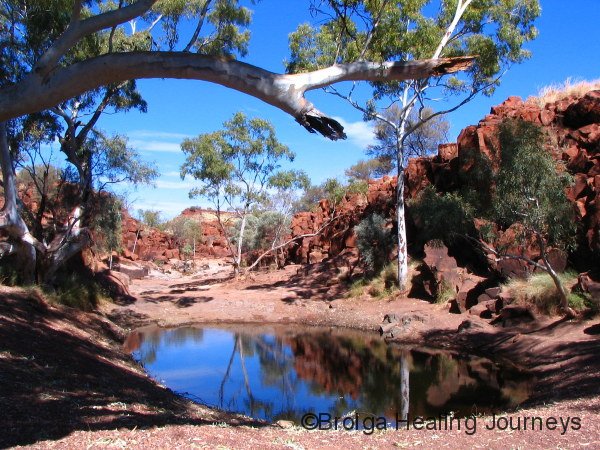
The sites also fill me with sadness because they represent a time now passed. The culture from which they sprang is now largely lost. You don’t see any new works at these sites, save for the occasional piece of modern graffiti. Despite the efforts to maintain traditional culture, successful in some Aboriginal communities, less so in others, the way of life that gave rise to these art sites, and the meaningful role played in everyday life by the artworks, has now been irretrievably lost. Indeed, I fear that in many areas the meaning of the artworks has been lost even to the local indigenous peoples. The sites now serve just as a reminder of the era when a once ancient culture prospered on our continent, before European settlement changed the human face of our country.
We now reside in a far different world, and there at Wanna Munna we were reminded again just what a small world that is. It turned out that the young woman we met was a recent graduate in archeology from the ANU, living in Watson in Canberra, now over in the west working for BHP in Newman for a month. Her job was to catalogue archeological sites at possible future mining sites. This had been her rostered day off and she had gone exploring. So we had a good chin wag with her about all sorts of topics, including news from home.
We continued our drive to Newman, the largest mining town in eastern Pilbara and the home of the world’s largest open cut iron ore mine. It is also within the largest shire in Australia (the Eastern Pilbara Shire, larger than either Victoria or Italy, so they say). WA seems to have a thing about size – most places bragging that they are home to the largest ‘[insert name here]’ in the state/country/world.
Anyway, the mine is bloody enormous. They have, in effect, removed a mountain and in its place left an enormous hole in the ground. We felt it our duty as patriotic Australians to go on at least one mine tour on our travels, so this was it. It did prove an interesting and awe inspiring experience. Everything is done there on a huge scale – trucks the size of buildings, water trucks carting around small lakes, 3km long trains etc. Enough to make one feel like an ant.
The tour coincided with my birthday (my last in the 40s) so we cut loose and went out to dinner in celebration. It was a lovely meal though the next morning we suffered a little from the celebratory drinks.
From Newman we explored some of the surrounding countryside, and drove along the “easy 4WD road” (ha! ha!) to Kalgan Pool. This was well worth the effort, and reminded us just how many beautiful places are largely hidden in the Pilbara. You can look at a map of the Pilbara and think – “there must be nothing there”, because there is so little in the way of towns or civilization. But our experience is that it is a tremendously interesting and varied region, and full of surprises.
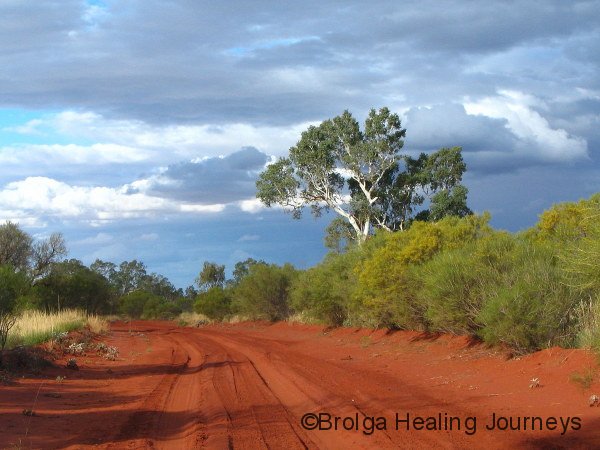
RUDALL RIVER NATIONAL PARK – SPECTACULAR COUNTRY & ROUGH ROADS
Now the time came for some serious adventure out to Rudall River National Park. Everything we read stressed its remoteness and warned against travelling there unless accompanied by a convoy of support vehicles, or something like that. Of course, being the adventurous souls (fools) that we are, we were determined to go there. So we stocked up, took as much diesel, food and water and emergency supplies of chocolate and wine as we could, left our travel details with the police station, took a deep breath, and off we went. The national park is reached by travelling east along the Talawana Track, one of the last major tracks made by the legendary Len Beadell and his Gunbarrel Road Company in the 1960s. We did the right thing and advised the Parrngurr (Cotton Creek) Aboriginal Community, which is on Talawana track and near the southern boundary of the national park, that we were visiting the park. They told us that the Talawana Track had recently been graded and “is like a freeway mate”. You beauty!! But the guy added that once we got to the roads in the national park, “disregard everything I just said”. Not so great!! Oh, and in case we needed diesel we could buy it at the community for $4 per litre, cash only. Luckily we had stocked up.
Anyway, the Talawana Track wasn’t too bad, though we realized that the concept of “freeway” is a relative one. The Track was mainly good, but there were still some very rugged stretches. Rugged enough to shake the car’s fuel gauge into oblivion, which, while not stopping us in our tracks, made my job of monitoring of our fuel levels a bit more challenging, bearing in mind that we were in a region where the nearest fuel was many hundreds of kilometers away. Anyway, we made good progress and towards the end of the day, some 320kms from Newman, we turned off the Talawana Track and headed north towards the national park. This 8km stretch was our first taste of what to expect from the roads in the park. Deep red sand and deeper corrugations. Often, with corrugated roads, you can reach a speed where you float across the top of them. Not these unfortunately; such an attempt would have destroyed the car and its occupants, as well as the camper trailer. So this meant grinding along at little more than walking pace, bouncing up and down like we were on some theme park ride. Occasionally, in short stretches where the road improved, we were about to cut loose to about 20kmh. At least the slow travel meant that we had time to enjoy the scenery (well, the passenger did anyway).
We finally reached White Gum Bore and set up camp in the large stand of – you guessed it – White Gums. It proved a lovely place in the late afternoon sun, with the full moon coming up over the sand hills. There was water in the bore and we were thrilled to discover that it was as nice as any water we had tasted on the trip. We had the campsite all to ourselves and stayed at White Gum Bore a couple of nights while I psyched himself up for the next leg of the trip further into the national park and thus further from help and, I feared, along even worse roads. Nirbeeja, intrepid soul that she is, wasn’t anywhere near as concerned as me and was simply soaking up the adventure. “The universe will look after us” was her answer to my voiced concerns about the road. And she was right – the universe did.
But I was right about the roads – we encountered 200kms or so of severe sandy corrugations, sharp rocky patches, and boulder strewn stretches that posed a real challenge given that we were towing. Anyway, we did survive the journey, with no more damage to the car. Apart from the relatively low clearance of our rig, which posed a few problems over rocky stretches, the car and trailer handled the conditions extremely well. I will, however, admit to having a few more grey hairs than at the start of the journey.
But enough of my whingeing about the roads – the park itself was beautiful and well worth the effort. We travelled north from White Gum Bore, covering around 70km in a full day’s travel, camping near the turnoff to Desert Queen Baths. This was a lovely overnight spot where we were surrounded by ancient escarpment. The cliffs glowed a deep orangey/red in the late afternoon and early morning light.

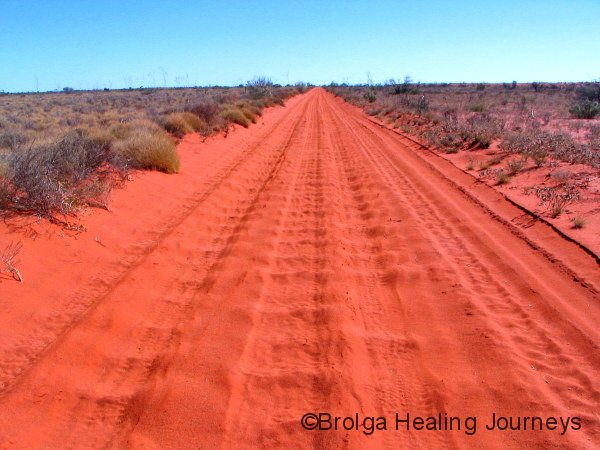
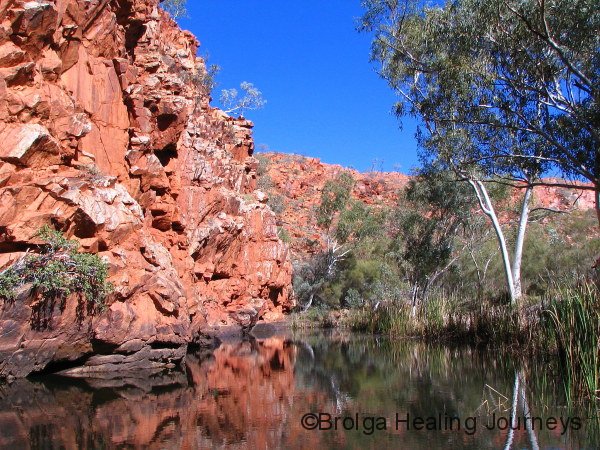
The following morning we turned onto the road (22km) to Desert Queen Baths. The first half was relatively easy driving by Rudall standards, then the road deteriorated into stretches where it was nothing more than a series of football sized rocks. After bottoming out on a number of occasions, albeit at slow pace, we wisely dropped off the camper trailer and continued the remaining distance by car alone. It was worth the effort. The Desert Queen Baths comprise a series of waterholes along a gorge in otherwise arid country. (Bear in mind that this region is on the fringes of to the Great Sandy Desert.) Ancient caves sheltered equally ancient Aboriginal rock art, but most dramatic were the engravings of three goannas high up on the cliff-face at the start of the gorge. We clambered up the gorge past a number of waterholes, coming eventually to the Desert Queen Bath. Nirbeeja, being the Desert Queen that she is, couldn’t resist a dip in its icy waters. I resisted, opting instead to scramble up the adjacent cliff-face for views up and down the gorge.
We were disappointed at not being able to camp at the site near the Baths, but consoled ourselves with a return to the camper, setting up camp there. We awoke the next day and looked around, taking in for the first time the full beauty of the surrounding countryside in that area. We stayed there for three nights in all, exploring nearby gorges and caves, wandering across the wide valley floor to other gorges and ancient caves (some of which had been Aboriginal shelters and art sites) and finding hidden waterholes on our own. I named one series the Desert King Baths. So while we may not have been able to stay at the Desert Queen Baths campsite, the chance to explore areas that very few people would ever venture into was something we will treasure always.
We returned to the main ‘road’, heading north, eventually crossing the park boundary and leaving Rudall River National Park. Our next campsite was beside a large permanent waterhole on Coolbro Creek. We were lucky to have good maps of the region, for without knowing the location of this campsite we could easily have driven past the apparently dry riverbed and never considered that a waterhole lay nearby; indeed we noticed a few cars drive by with no sign of slowing. We were amazed at the beauty and size of the waterhole and its birdlife, all the more given the barren country on all sides. Again we stayed for three nights.
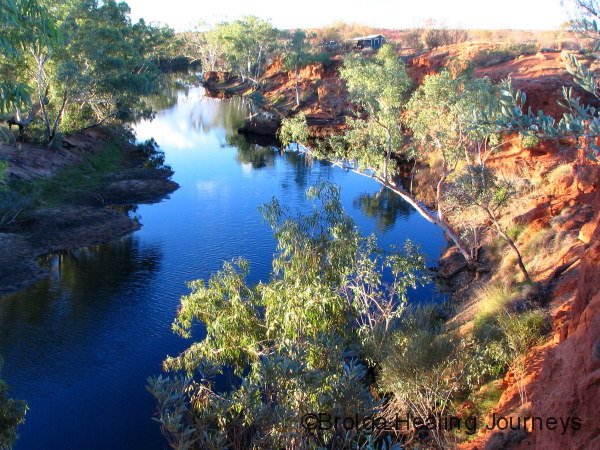
I always enjoy exploring the country around our campsites, so I wandered off around the surrounding hills one afternoon. I was astonished to discover an even larger waterhole than that beside which we were camped, a kilometre or so upstream from us. Further explorations with Nirbeeja the next morning turned up three more large waterholes upstream (by large, we mean at least 1km long). These were pristine waterholes, full of bird life and incredibly peaceful. Who knows how many other such holes lay further upriver? The Pilbara, just when we thought we had found so much, had surprised us again. (Interestingly, Coolbro Creek appears not to join any larger rivers, but most likely drains eventually into Lake Dora, in the even more remote eastern side of Rudall River National Park. From there, any water simply evaporates or soaks into the groundwater.)
We departed our Coolbro campsite on a windy day, stopping off to view Christmas Pool, a seasonal waterhole that was dry at the time of our visit. The Martu Aboriginal people of the region would come to the pool while it held water and harvest seeds from nearby plants, grinding the seeds into an edible paste. Many grinding grooves made during this process are visible in the sandstone bedrock surrounding the pool. The occupation of the area by the Martu people dates back many thousands of years. Their ties to the country have remained strong and people continue to live in small communities in these desert regions (Cotton Creek is one such community).
The pool also features in European history in the region. The pool served as the base for an unsuccessful search mounted in 1896-97 for two missing members of a scientific expedition in the region. The remains of the missing men were never found. One of three search parties spent Christmas next to the pool; thus its name. The names of members of the search-party are still engraved on the rocks surrounding the waterhole. Indeed, the Rudall River itself was named after the then Government Surveyor of WA, William Rudall, who had been involved in these searches and had met pastoralist Frank Hann at a spot later named Meeting Gorge, now within the western boundary of the national park. Hann named the river that now bears Rudall’s name.
Anyway, we continued our journey. Eventually we neared the Telfer Goldmine north of Rudall, and the roads – maintained by the goldmine – improved enormously. All I need say about my joy at travelling again on these smooth roads is that Telfer is currently my favourite Australian corporation.
We found a sheltered campsite nestled among a beautiful stand of wattle near the abandoned Ragged Hills Goldmine, explored those parts of the old mine-site we felt were safe, then continued our journey, now heading west in the vague direction of Marble Bar.
CARAWINE GORGE – A LITTLE PIECE OF HEAVEN
We decided to visit Carawine Gorge, en route to Marble Bar, on the off- chance that we might camp there for a night or so. We drove in and couldn’t believe our eyes. This was the most beautiful place we had seen. A huge cliff-face, a waterhole many kilometers in length, we counted at least 30 species of birds, beautiful grassy campsites and fish everywhere. And camping there is free. This place had it all!! We were entertained by huge flocks of Little Corellas making their way to and from the gum trees nearby, their raucous squawking almost deafening as they flew by. We saw flocks of beautiful Rainbow Bee-eaters elegantly swooping and banking across the water catching their insect prey. There were finches, wrens, water birds such as Black Swans, Australasian Grebes (Nirbeeja’s current favourites) and Pacific Black Ducks. There were Spinifex Pigeons, Crested Pigeons, Peaceful Doves and Diamond Doves. There was also a resident White-Bellied Sea-Eagle, even though we were over 200km as the crow flies (or eagle soars, in this case) from the nearest ocean. Each morning the cliff-face opposite our campsite was perfectly reflected in the still waters of the gorge, and at night the Milky Way was bright and shooting stars frequently seen. I had quite an effort getting Nirbeeja to leave Carawine Gorge, but we had other things to do and other places to go. Indeed, I think I could have left her there and, distracted by the wildlife, she wouldn’t have noticed my absence for a couple of weeks.
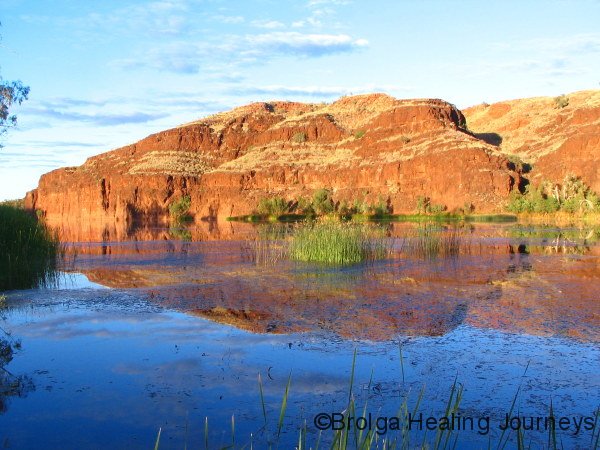
MARBLE BAR – A FRIENDLY WELCOME BACK TO CIVILISATION
Still, off we headed, making our way in to Marble Bar and thus, after a couple of weeks in complete wilderness, back to civilization. At least it was a soft re-entry. Marble Bar is a small town with around 300 to 400 residents, and we were surprised at its friendliness; even the children politely say hello and start up a conversation with you in the street (unlike a lot of the city kids). We enjoyed our stay there, having a counter meal and a couple of drinks at the famous Iron Clad Hotel, and exploring the district.
The Marble Bar after which the town was named, was spectacular. In fact, the large bar of beautiful coloured rock is jasper, not marble, as was once thought. Overnight rain had washed the rock clean and puddles of water nearby allowed us to bring out the stunning colours of the Jasper to full effect. It was the most beautiful rock formation we had seen – quite a statement in the Pilbara where beautiful rock formations are commonplace. Fortunately, the rock is now protected and a fine of $10000 applies to anyone caught removing any from the site.
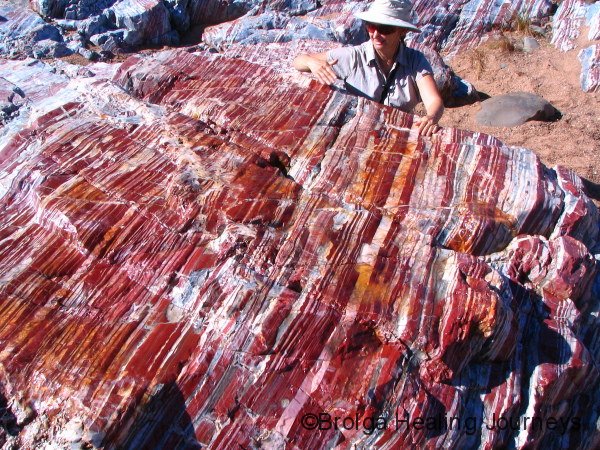
We continued our travels westwards in the vague direction of Port Hedland, where our car was to be serviced. We stopped off at another free-camp, this time at Doolena Gorge on the Coongan River. Although not the equal of Carawine Gorge, it was nonetheless a beautiful place and the sunset reflections breathtaking. Again, water-birds were abundant, with Pelicans the most numerous there.
PORT HEDLAND – BETTER THAN EXPECTED (HOW’S THAT SOUND FOR A TOURISM JINGLE?)
We entered Port Hedland with few expectations, and whilst it isn’t a town that you would tell people not to miss, it was nicer than we expected. It is an industry-based town but there is plenty of history that the long-term locals are proud to share with visitors. For instance, we saw photos of the once white sands of the town beach, now stained dark red as a result of decades of iron ore shipments through the port. And I managed to locate a tremendous collection of Aboriginal petroglyphs, which have been dated to several thousand years of age, spread along a limestone shelf, symbolically next to the huge BHP factory. Without knowing its whereabouts the art-site could easily be mistaken for wasteland. I think this says much about our priorities.
We stayed out on Cooke Point near Port Hedland, in a very pleasant caravan park, but which was the most expensive of our trip. Nirbeeja and I both thought it ironic that the most beautiful, pristine campsites we had found (albeit in remote areas) were free, while those in industrial towns the most expensive. What is the message there, we wondered? Actually, for us the answer is simple – we should spend most of our time in the bush!
And that, indeed, is where this blog is being written; in a beautiful spot among the eucalypts and melaleucas beside the DeGrey River north-east of Port Hedland.
Till next time.
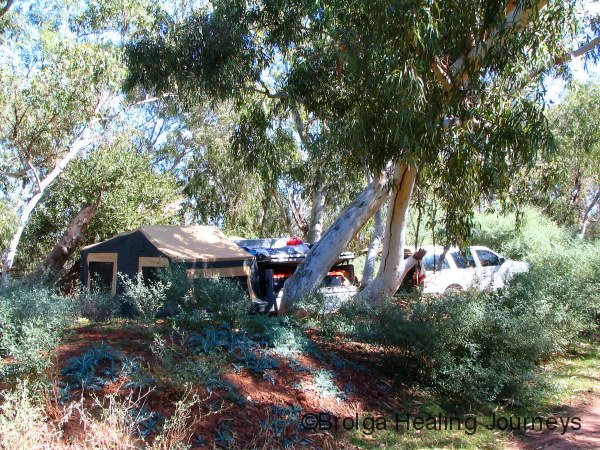
Peter & Nirbeeja
25 June 2009























































































































